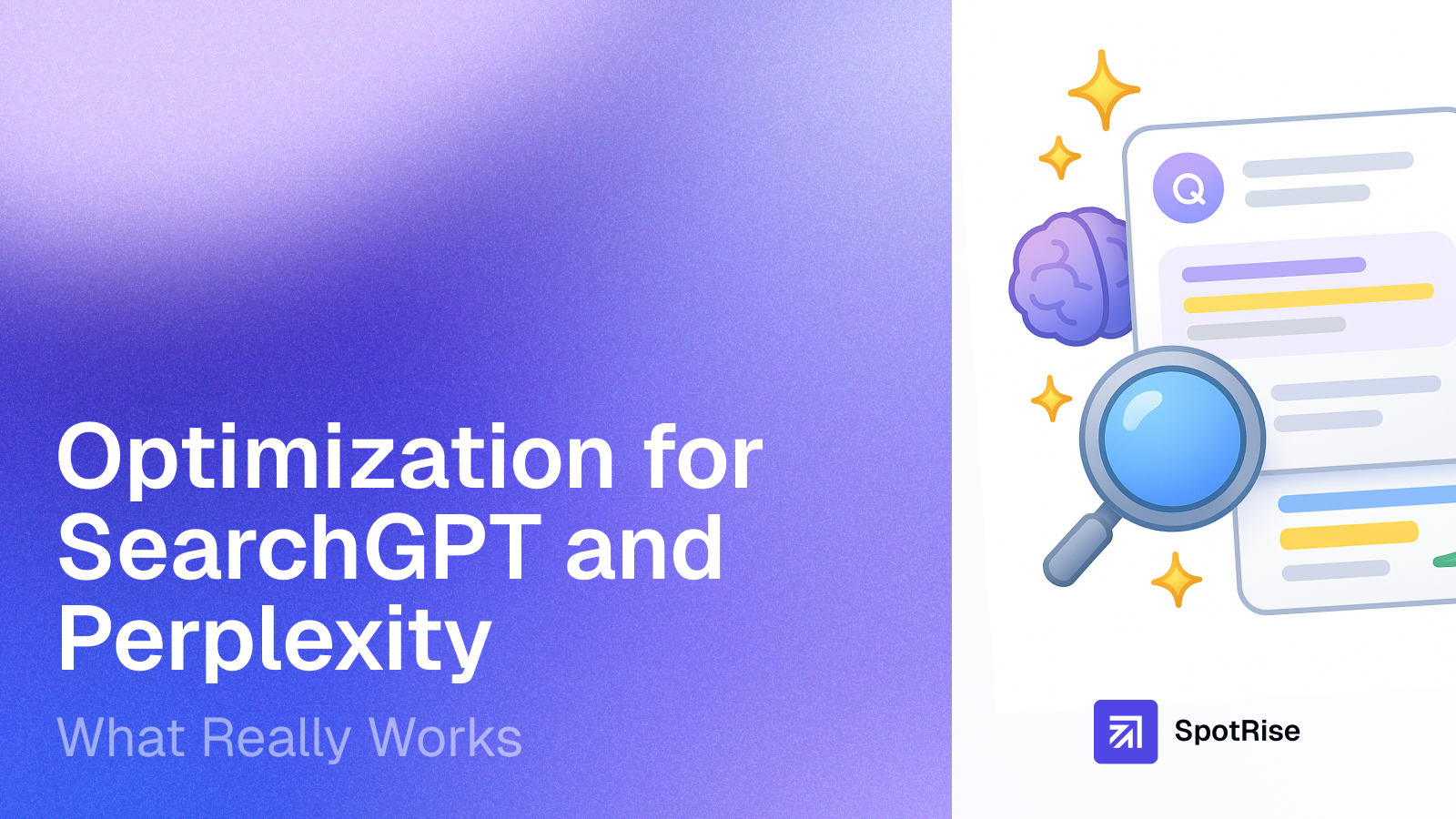November 21, 2025
Semantic Blocks: The New Structure of AI-Optimized Content
November 20, 2025
Multimodal SEO: How AI Uses Images, Video & Diagrams to Rank Pages
November 19, 2025
Author:

Search is evolving faster than ever. What used to be a simple list of blue links is now being replaced by AI-generated summaries that answer users’ questions directly within the search interface. This shift marks the beginning of a new era - AI Search Optimization.
Platforms like SearchGPT (OpenAI’s integrated search inside ChatGPT) and Perplexity AI are leading this transformation. Instead of sending users to websites, they synthesize information from multiple sources and present concise, context-aware answers - often citing the most relevant domains.
For SEO professionals, this changes the entire playbook. Ranking #1 on Google no longer guarantees visibility. The question is no longer “How do I rank?”, but “How do I get featured in AI answers?”
In 2025, SEO is about visibility inside AI responses, not just in search results. Brands that adapt to this new discovery model will capture attention even when users never click a single link.
Two of the fastest-growing AI search engines - SearchGPT and Perplexity AI - are redefining how people discover information online. Both deliver direct, conversational answers, but they operate in distinct ways that deeply affect SEO strategy.
SearchGPT is OpenAI’s built-in search layer inside ChatGPT, powered by Bing Search and OpenAI’s proprietary models. It uses contextual understanding to provide personalized, intent-aware answers - meaning the same query may produce different responses based on a user’s previous conversations or preferences. It’s less about ranking pages and more about selecting the most relevant insights to build a natural, human-like answer.
Perplexity AI, on the other hand, functions as an independent AI-powered search engine that pulls real-time data from the web. It cites its sources directly, combining elements of traditional search and generative summarization. For SEOs, this means visibility is measurable - you can see which pages get cited and how often your brand appears in AI responses.
The key difference:
Both platforms represent the next generation of search. For content creators and SEOs, understanding how to appear in these AI answers isn’t optional - it’s becoming a new pillar of organic visibility.
{{optimizationgpt="/rich-text-elements"}}
Unlike traditional search engines that rank pages by backlinks and CTR signals, AI search engines operate on a three-step process: retrieval, summarization, and citation.
They don’t just display a list of results - they read, interpret, and rebuild the web’s information into a conversational answer.

AI systems like SearchGPT or Perplexity first scan their index (Bing or live web) to identify the most relevant documents. This stage is still influenced by classic SEO signals such as crawlability, page structure, and keyword context - but semantic understanding now plays the dominant role.
Once relevant sources are retrieved, the model summarizes them into a unified, human-readable response. At this stage, clarity, factual density, and topical coherence determine whether your content gets selected for synthesis. AI prefers concise statements that can be directly quoted or paraphrased.
Finally, the model decides which sources to cite. Platforms like Perplexity make these citations visible, while SearchGPT may include them implicitly. In both cases, being “chosen” means your content influenced the generated answer - even if users never click your link.
In AI-driven search, “ranking” doesn’t mean position #1 - it means being cited, summarized, or referenced inside the answer.
Visibility now lives inside the content itself, not just on the results page.
Optimizing for SearchGPT requires a shift from keyword-driven SEO to language model–driven optimization.
Instead of convincing a search algorithm to rank your page, you’re helping an LLM (Large Language Model) understand, extract, and trust your content.
Below is a practical framework for improving your visibility inside SearchGPT-generated answers.

SearchGPT consumes content the same way a human would - by reading it in full context. But it also depends on structure and clarity to decide what’s relevant.
Best practices:
To help SearchGPT understand your page purpose, make it as machine-readable as possible.
Recommended actions:
SearchGPT extracts content that’s concise, factual, and self-contained. The more “quotable” your text is, the higher the chance it will be included in an AI summary.
How to do it:
SearchGPT relies heavily on recency signals from Bing’s index. Pages updated frequently are more likely to appear in its retrieval set.
To stay competitive:
By combining semantic clarity, structured markup, and recency optimization, your content becomes far easier for SearchGPT to understand - and more likely to be surfaced, summarized, and cited inside AI-generated answers.
While SearchGPT prioritizes context and personalization, Perplexity AI focuses on credibility and transparency. Every answer it generates includes direct citations, which means SEO visibility depends on how quotable and trustworthy your content appears.
Perplexity rewards content that looks and feels factual. To increase the odds of being cited:
Example:
“According to the European Automobile Manufacturers’ Association (ACEA), the average car in Europe travels over 11,000 kilometers per year.”
Perplexity reads and segments pages into mini-snippets. If your content is cleanly structured, you increase the chance of being chosen.
Best practices:
Perplexity’s retrieval algorithm favors websites that show consistent expertise around one theme.
To build that authority:
Tracking visibility inside AI results is now as important as tracking SERP rankings.
Even in AI search, the technical foundation of SEO remains critical. Both SearchGPT and Perplexity rely on structured, crawlable, and accessible pages to extract accurate information.

Core technical signals:
Traditional SEO metrics like impressions and clicks no longer capture full visibility. AI Search introduces new measurement dimensions that reflect how often your brand is mentioned or cited in AI-generated content.

Key metrics to track:
SpotRise.ai and similar analytics platforms can automate AI visibility tracking, aggregating mentions, citations, and estimated reach - giving SEOs the same level of insight into AI traffic that they once had for organic traffic.
The era of AI-native search has officially begun.
In 2025 and beyond, optimizing for visibility will mean more than competing for blue links - it will mean earning presence inside the language models themselves.

Traditional SEO was about ranking.
AI-native SEO is about representation - ensuring your content is chosen, cited, or summarized by generative engines like SearchGPT, Perplexity, Bing Copilot, and Gemini.
Generative Visibility Optimization (GVO) focuses on three pillars:
As AI search adoption grows, the click will matter less - and visibility inside AI summaries will become the new ROI metric.
Brands that adapt early will control the narrative users see in generative responses. Those that don’t risk becoming invisible - even with strong rankings.
SEO is no longer just about getting clicks - it’s about being trusted by AI.
When language models start using your content as a source of truth, your brand’s visibility extends far beyond the search results page.
The companies that master Generative Visibility Optimization today will define what people - and AI - know tomorrow.
Your new AI assistant will handle monitoring, audits, and reports. Free up your team for strategy, not for manually digging through GA4 and GSC. Let us show you how to give your specialists 10+ hours back every week.
Read More

November 21, 2025
10 min

November 20, 2025
10 min

November 19, 2025
10 min
Just write your commands, and AI agents will do the work for you.